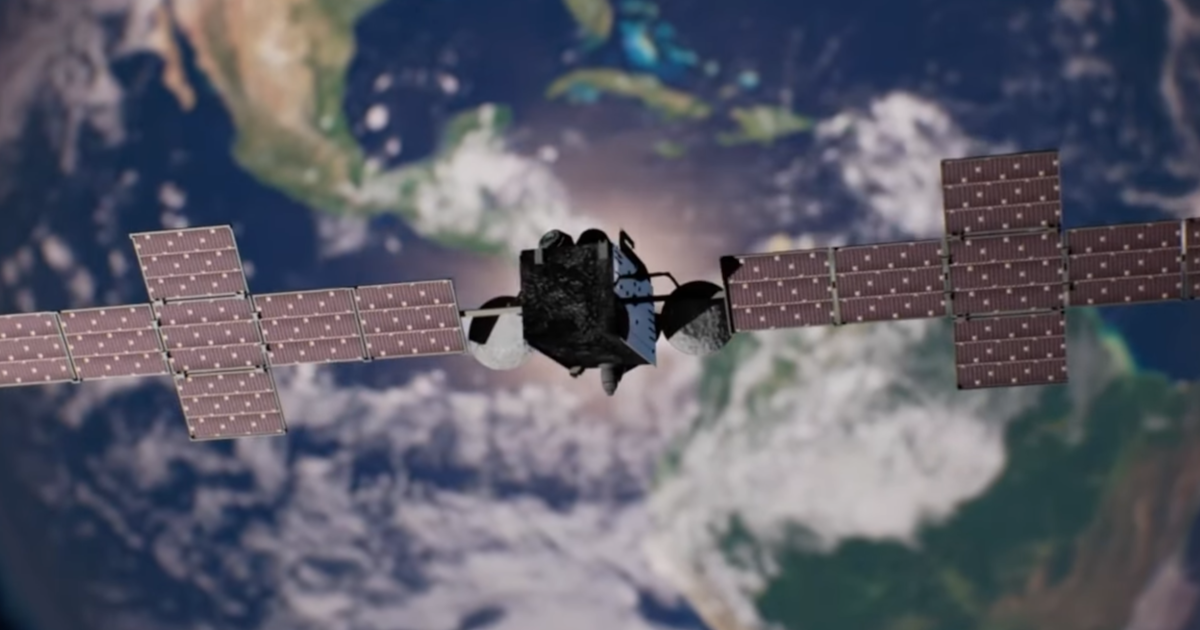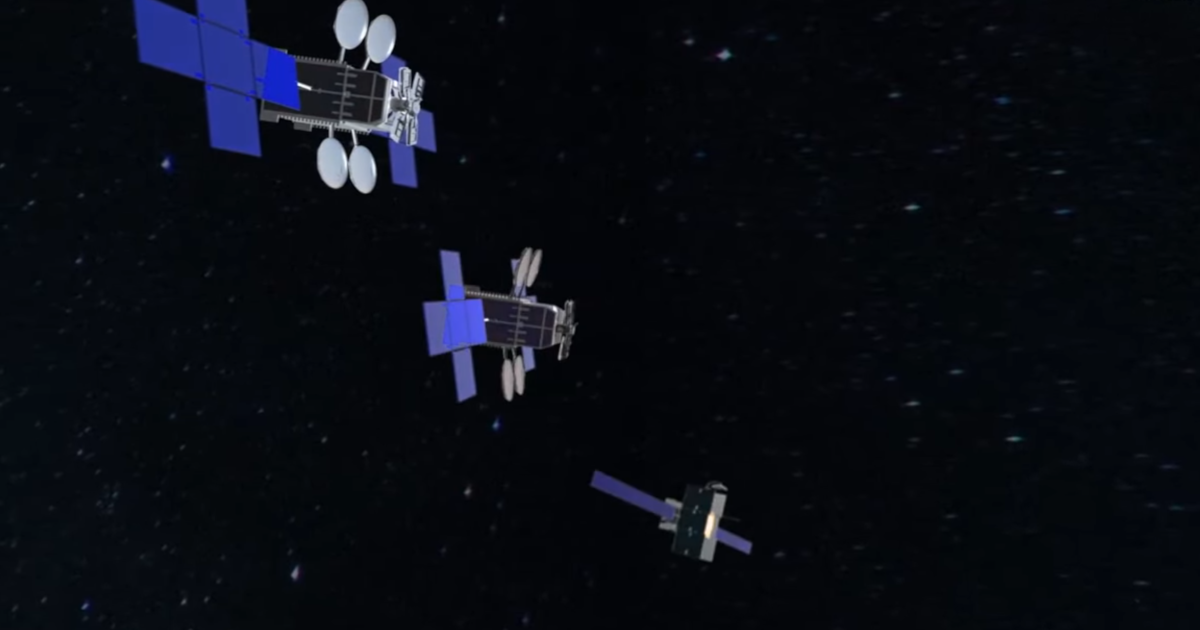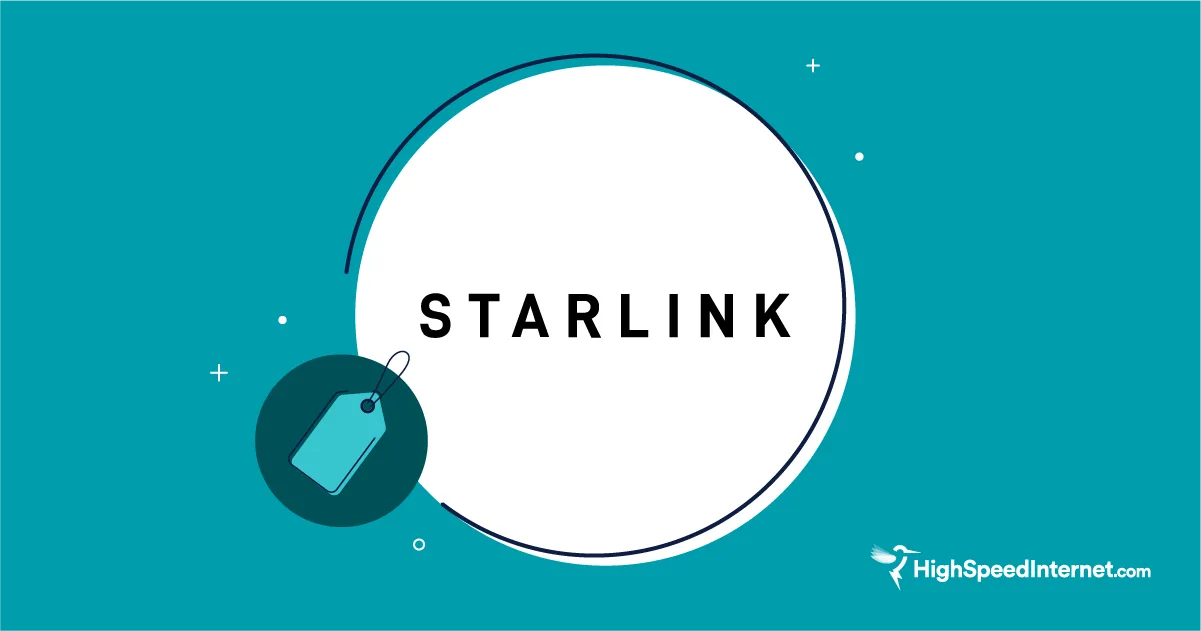What the Jupiter-3 Satellite Means for the Satellite Industry
Hughesnet rolls out a new satellite and new internet plans
Apr 5, 2024 | Share
Brand Guides, News
On July 28, 2023, Hughesnet’s Jupiter-3 satellite (also known as EchoStar XXIV) launched from Cape Canaveral aboard a Falcon Heavy rocket, heading toward a geosynchronous orbit. On November 16, the provider announced that the satellite had successfully deployed its solar panels and antennas, making it the largest commercial telecommunications satellite ever put into orbit.
This new satellite dramatically changes the landscape of the satellite internet market and, in turn, the way that we think about rural internet options. 2023 has been a year of ups and downs for satellite technology, but it looks like we might close out the year with one of the biggest shifts of all.
What is the Jupiter-3 satellite?

Jupiter-3. Image courtesy of Hughesnet.
Jupiter-3 is a geosynchronous orbit (GSO) communication satellite built by Maxar Technologies for Hughesnet and its parent company, EchoStar. It’s the third high-throughput satellite in the Jupiter fleet, as Jupiter-1 and Jupiter-2 launched in 2012 and 2016, respectively. Although there were delays on top of the already lengthy construction time, it seems like it was well worth the wait. Jupiter-3 adds more than 500Gbps in capacity to Hughesnet’s satellite network, more than doubling the previous throughput of the Jupiter fleet.
Unsurprisingly, Jupiter-3 is a massive piece of equipment. The body of the satellite is the size of a bus and with its 14 solar arrays fully extended, it measures 127 feet from end to end. With a weight of about nine metric tonnes (9,000 kg), it’s approaching the size of the Hubble Space Telescope, which weighed in at 10,800 kg at the time of its launch.

Jupiter-3. Image courtesy of Hughesnet.
Besides being larger than the previous two Jupiter satellites, Jupiter-3 also has other technological improvements. Its highly efficient spot beam antennas use 300 beams to direct the satellite transmissions to specific locations, allowing speeds up to 100Mbps, the first time Hughesnet has been able to offer these speeds to its customers.
Jupiter-3 also increases the reach of Hughesnet’s coverage, reaching 80% of the population in both North and South America.
New tech in orbit and on the ground
Although Jupiter-3 is a key component of Hughesnet’s network, there’s a lot more to satellite internet than just the satellites. When you use a satellite connection, the satellite is only the halfway point for your data. Your web server request travels from the antenna on your home, up to the satellite, down to a ground station, then through physical internet cables to the server you’re looking for. The webpage is then sent back through this same path until it reaches your computer.

Ground-based satellite teleport. Image courtesy of Hughesnet.
To get the most out of the massive increase in network capacity offered by the Jupiter-3 satellite, Hughesnet has also been making improvements to its ground facilities. The provider currently operates 18 active gateways for satellite teleport, distributed across the country. This also makes it possible to route traffic around storms and other weather conditions that could interfere with people’s internet connection. Because of its position in a distant geosynchronous orbit, Jupiter-3 has line of sight to all of these ground stations at all times, which avoids some network management issues that low-Earth orbit (LEO) satellites have to deal with. According to Mark Wymer, Senior Vice President for Strategy and Distribution at Hughesnet:
“Our network is fully redundant, so if you think of the magnitude of customers that a satellite of that size could support, you want to make sure that there’s no downtime at all. So now it has handoff capability between the gateways and we can shift and move traffic to truly optimize it on the terrestrial side, which then ensures that we get maximum performance out of the satellite itself.”
Managing network traffic is an ongoing challenge for satellite providers. This has typically resulted in satellite providers using various types of restrictions and data caps to manage traffic, even as most wired providers have made unlimited data standard.
Hughesnet has begun implementing AI to constantly monitor and analyze traffic on its network in order to avoid the kind of congestion that otherwise requires draconian data policies to manage. Wymer notes, “AI is constantly monitoring that network and routing that traffic to ensure that we’re providing the best service we can.” This has allowed the company to do away with throttling or capping speeds and move toward a model that more closely resembles Starlink’s data plans.
How does this new satellite impact Hughesnet service?
With the addition of Jupiter-3 to its satellite network, Hughesnet has made some massive changes in the plans it offers and the way its service works in general:
- Hughesnet now offers plans up to 100Mbps.
- All new Hughesnet plans come with unlimited standard data.
- Hughesnet equipment is now Wi-Fi 6 enabled.
This is a dramatic shift from Hughesnet’s old business model and really changes the way it fits into the satellite internet ecosystem. It now offers plans that can go toe-to-toe with the premium plans of other providers like Viasat and Starlink, which means that even if Hughesnet didn’t fit your needs in the past, it’s worth taking a second look.
New Hughesnet plans
| Package | Price* | Speed | Priority Data | Details |
|---|---|---|---|---|
| Hughesnet Select | $49.99/mo. for 12 mo. | Up to 50Mbps | 100GB | |
| Hughenet Elite | $64.99/mo. for 12 mo. | Up to 100Mbps | 200GB | |
| Hughesnet Fusion | $94.99/mo. for 12 mo. | Up to 100Mbps | 200GB |
Data as of 4/5/2024. Offers and availability may vary by location and are subject to change.
*Service plan availability varies based on geographical area. 24-month commitment required. Monthly Fee reflects the applied $5 savings for ACH enrollment. Enroll before the 2nd billing cycle for continued savings.
Hughesnet has completely revamped its plan offerings for both Hughesnet Fusion and satellite-only plans. Plans now start at 50Mbps (which was previously the highest speed available in its premium plan) and go up to 100Mbps. There is now only one Fusion plan, which comes with speeds up to 100Mbps.
With higher speeds and low-latency connections through the Hughesnet Fusion plan, Hughesnet is now a viable option for those in rural areas who expect more out of their internet connection.
New data policy
Perhaps even more exciting than the higher speeds is the change to Hughesnet’s data policy. Previously, Hughesnet plans had a consistent speed of 25Mbps, with the only difference between plans being the amount of data you were allocated for the month. When the data ran out, your connection wasn’t completely cut, but it was severely throttled until you purchased data tokens to get through the rest of the month.
With Hughesnet’s new data policy, every plan comes with unlimited standard data. Plans also come with a certain amount of priority data, which can be replenished with data tokens. Also, similar to before, data used between 2 and 8 a.m. doesn’t count against your monthly quota of priority data, making it an excellent time for software updates or other large downloads.
As implied by the name, connections using priority data on the network are given priority over those using standard data, which is handled using a best-effort connection. The biggest distinction between Hughesnet’s new approach and its previous one is that standard data is never artificially throttled. You can still theoretically get the full 50Mbps or 100Mbps download speed on standard data when there’s limited traffic on the network. If, however, there are too many people using priority data, their data will be prioritized over yours, resulting in lower speeds.
It’s also worth noting that the overall amount of priority data you get is quite a bit larger than the data caps on older plans, so lots of small improvements all around when it comes to data.
Hughesnet’s new unlimited data isn’t quite the same as the completely unlimited data you see from wired internet providers, as there are a lot of asterisks that go along with the word unlimited. Still, this is a major shift that will make a big difference to Hughesnet customers. We love seeing providers drop the data caps and other imposed restrictions on internet use, and this is a huge step in the right direction.
New equipment
In order to make use of these new, faster plans, Hughesnet has rolled out all new equipment using the Wi-Fi 6 standard. This upgrade is especially important for those who have a smart home or a lot of other Wi-Fi enabled devices. One of the main strengths of Wi-Fi 6 is its ability to manage lots of devices simultaneously on your home network. With faster speeds and fewer concerns about conserving data, using these devices in rural areas is now much more practical.
| Equipment | Satellite Plans | Fusion Plans |
|---|---|---|
| Monthly lease fee | $14.99/mo. | $19.99/mo. |
| Lease setup fee | $99.00 | $99.00 |
| Purchase fee | $299.99 | $449.99 |
| Wi-Fi modem | HT3000W (Wi-Fi 6) | HT3000W (Wi-Fi 6) + WL3000 |
| Mesh Wi-Fi node (lease) | $5.00/mo. | $5.00/mo. |
| Mesh Wi-Fi node (purchase) | $99.00 | $99.00 |
| Professional installation (lease) | Free† | Free† |
| Professional installation (purchase) | $199.99 | $199.99 |
†Free standard professional installation applies to new Lease subscribers only. Not valid with Purchase option. Limited-time offer.
Along with an upgrade to Wi-Fi 6, another new addition to the list is the option to lease or purchase a node to set up your own mesh network in your home. Mesh networks allow you to extend your Wi-Fi signal from various nodes throughout your home, rather than just a single signal broadcast from your router. Mesh networks allow you to extend the range of your network and avoid dead zones where a wall or other obstacle blocks your Wi-Fi signal in certain areas of your home.
Maintaining a rural focus
The increase in speed and the removal of data restrictions thanks to the Jupiter-3 satellite opens up Hughesnet to a whole new range of potential customers. Despite this, Hughesnet still maintains a focus on providing a widely accessible service in rural areas. This is in contrast to other providers like Starlink, for example, which also offers low-latency and high-speeds, but has higher up-front costs and long waits for equipment.
Wymer describes Hughesnet’s focus on rural connectivity as a practical solution for the lack of infrastructure in less populated areas:
“Historically, we have always grounded ourselves in the rural and the low-density areas. We’ve probably been the only technology that’s really embraced that. And Why? Because we build a cost-effective solution that actually delivers service there.”
As the internet continues to grow more central to everyday tasks like accessing healthcare and education, it’s important for people in rural areas to have access to the same opportunities as those in bigger cities.
What does this mean for current Hughesnet customers?
These improvements are all good news for current Hughesnet customers. However, they won’t have an automatic effect on current subscribers’ connections. In order to take advantage of the new plans, Hughesnet customers will have to upgrade their equipment and sign up for a new plan.
When we spoke with Hughesnet, it assured us that there would be a path for current customers to upgrade to the new systems, but the upgrade would not be automatic at this point. That means if you’re a Hughesnet customer, you’ll need to proactively contact customer service and find out how to upgrade your connection in order to get faster speeds and fewer data restrictions.
While upgrading to the new service isn’t mandatory, it’s probably the best option for the majority of Hughesnet customers. Unless you have low internet needs and are currently on a cheaper plan that works for you, upgrading will give you a much better online experience and in some cases, might even be cheaper than your previous plan.
Jupiter-3 and Fusion
The new capabilities of Hughesnet’s service thanks to the launch of the Jupiter-3 satellite pair quite nicely with Hughesnet’s big announcement from a year ago: the launch of Hughesnet Fusion, its hybrid satellite service. This combination of GSO satellite service and terrestrial wireless allows satellite customers to engage in activities like online gaming that require low latency—a physical impossibility with GSO satellites alone.
According to Wymer, Hughesnet Fusion is currently available in about 70% of the company’s coverage area, though it’s working to expand this availability. EchoStar, Hughesnet’s parent company, has also acquired a license for a large portion of the electromagnetic spectrum through its merger with DISH Network, which could be utilized as part of this expansion as well.
Over the last few years, most of the innovation and activity in satellite internet has been related to the emergence of LEO satellite constellations like Starlink, Project Kuiper, and OneWeb. Hughesnet approached the same problem from a different angle. On the subject of Hughesnet’s relationship to LEO satellites, Wymer said, “Our Fusion product was the solution that we brought forward to be competitive with LEO in the rural footprint.” Like LEO constellations, Hughesnet Fusion gets around the problem of latency with GSO satellite internet, but rather than pioneering new satellite technologies, it relies on proven wireless technologies that have been in use for decades.
With the launch of the Jupiter-3 satellite, Hughesnet’s Fusion service is now comparable to Starlink not only in terms of latency, but speed as well. As individual internet usage as well as the use of Wi-Fi enabled devices continues to grow, rural customers will continue to demand more from their internet connection. Rural communities need more and better internet options, and we’re excited to see innovation continue in these spaces.
Future of Hughesnet
The long-awaited addition of the Jupiter-3 satellite is a huge achievement for Hughesnet, but there’s still lots to do. Wymer pointed out that all of the Jupiter satellites have been huge improvements right at launch, but engineers continued to make them better for months after they had begun operations.

Hughesnet Jupiter fleet. Image courtesy of Hughesnet.
Hughesnet’s other major focus is its Fusion service. Hughesnet Fusion not only allows the provider to balance data that needs low-latency with data that needs higher throughput, but it also provides another way to manage traffic across the entire network to improve reliability and avoid slowdown.
Wymer also anticipates new innovations and new opportunities as DISH is integrated into the other EchoStar companies. There are a lot of exciting things happening at Hughesnet right now, and we’re looking forward to seeing what other changes we see in the near future.
More resources
If you’re interested in the current developments in the satellite internet industry and what might be on the horizon, we have several other articles available on the topic.
- When Will Project Kuiper Be Available?
- When Will OneWeb Satellite Internet Be Available?
- What Is Hughesnet Fusion?
- What Happened to Viasat’s New Satellite?
- Viasat Buys Inmarsat and Its Plans for a LEO Constellation
- Starlink Roam Is Here, but Is It Worth It?
Author - Peter Christiansen
Peter Christiansen writes about telecom policy, communications infrastructure, satellite internet, and rural connectivity for HighSpeedInternet.com. Peter holds a PhD in communication from the University of Utah and has been working in tech for over 15 years as a computer programmer, game developer, filmmaker, and writer. His writing has been praised by outlets like Wired, Digital Humanities Now, and the New Statesman.




